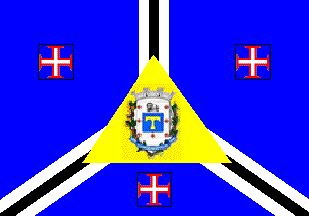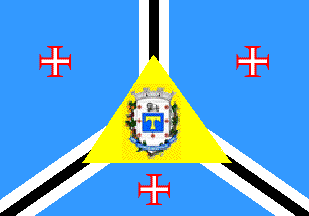 image by
Ivan Sache, 26 March 2013
image by
Ivan Sache, 26 March 2013
Last modified: 2013-04-06 by ian macdonald
Keywords: sao paulo | cordeirópolis |
Links: FOTW homepage |
search |
disclaimer and copyright |
write us |
mirrors
 image by
Ivan Sache, 26 March 2013
image by
Ivan Sache, 26 March 2013Cordeirópolis originates in the inauguration in 1876 by "Companhia
Paulista de Estradas de Ferro" of the railway station of Cordeiro,
named for the domain of the same name. The colonial nucleus of
Cascalho was established in 1884 by the provincial government on land
purchased from Domingos José Nogueira Jaguaribe, which increased
traffic in the railway station. Manoel Barbosa Guimarães founded there
in 1885 the chapel of Santo Antônio do Cordeiro. The district of
Cordeiro was established by State Law No. 645 of 7 August 1899 and
renamed Cordeirópolis by State Decree-Law No. 14,334 of 30 November
1944, following a plebiscite organized in 1943.
The municipality of Cordeirópolis was established by State Law No. 233
of 24 December 1948.
http://www.cordeiropolis.sp.gov.br - Municipal website
The symbols of Cordeirópolis are prescribed in Article 5 of the
Municipal Constitution, adopted on 5 April 1990, as "the coat of arms,
the flag and the anthem, representative of its culture and history".
http://www.camaracordeiropolis.sp.gov.br/2009/arquivos/leiorganica.pdf - Municipal Constitution
The flag and the coat of arms, designed by Arcinóe Antônio Peixoto de Faria in compliance with the traditions of the Portuguese heraldry inherited by Brazilian heraldry, are prescribed by Municipal Law No. 483 of 26 April 1967, modified by Municipal Law No. 1,793 of 20 October 1993. The flag is blue, quartered by three white-black-white stripes emerging from a yellow triangle placed in the middle of the flag and charged with the municipal coat of arms. Each quarter of the flag is charged with a red cross patty filled in white.
The coat of arms represents the municipal government, while the triangle that inscribes it represents the town as the seat of the municipality. The stripes represent the municipal power spreading all over the municipal territory. The quarters represent the rural estates located on the municipal territory. The crosses patty recall the first flag and first symbol used in Brazil, evoking the ethnic origin of people. The stripes emerging from the central triangle highlight the significance of Cordeirópolis as a road and railway junction; Cordeirópolis is the "irradiation center" of roads that serve the most important regions of the State.
The coat of arms is "A Samnitic shield surmounted by a six-towered mural crown argent. Azure a tau cross, a bordure argent seven crosses patty gules voided argent in chief a spinning wheel sable. The shield supported dexter by branches of orange tree and coffee and sinister by a sugar cane the three proper. Beneath the shield a scroll azure inscribed with the municipality's name surrounded by the years '1889' and '1948' all argent".
The Samnitic shield, the first style of shield introduced in Portugal
from France and inherited by the Brazilian heraldry, evokes the
colonizing race that mainly built our nation.
The six-towered mural crown argent represents a third-rank town, seat
of a municipality.
Azure is a symbol of justice, nobleness, perseverance, zeal and
loyalty. The tau cross is the symbol of St. Anthony, the
municipality's patron saint, and recalls the early name of the place,
Santo Antônio de Cordeiro. Or is a symbol of nobleness, wealth,
splendour and prosperity.
The bordure is a symbol of favour, protection and reward. The crosses
patty recall the first flag and first symbol used in Brazil, which was
inherited from Portugal. Argent is a symbol of faith, religious
feeling, peace, labour, achievement and hospitality.
The spinning wheel in chief recalls that the town is said to originate
in an inn frequented by muleteers coming from a town where ropes
("cordas") were manufactured and sold in the hinterland. The spinning
wheel also recalls that cloth making is the main industry in the town.
The branches of coffee and orange tree represent the main past and
present products of the generous and fertile soil, as does the
sugarcane.
The years "1889" and "1948" are those of the establishment of the
district and of the municipality, respectively.
http://cmcordeiropolis.locaweb.com.br/camver/LEIMUN/1967/00483.pdf -
Municipal Law No. 483 of 26 April 1967
The Municipal Law No. 1,793 of 20 October 1993 slightly amended the
coat of arms, correcting the year "1889" to "1899" on the scroll.
http://cmcordeiropolis.locaweb.com.br/camver/LEIMUN/1993/01793.pdf -
Municipal Law No. 1,793 of 20 October 1993
The flag appears to be used with different shades of blue.
Photos of the flag with a rather light blue (lighter than on the
Brazilian flag)
http://www.camaracordeiropolis.sp.gov.br/2009/fotos_sessoes/201301110534496.jpg
http://www.camaracordeiropolis.sp.gov.br/2009/fotos_sessoes/20091006080533(8).jpg
http://www.camaracordeiropolis.sp.gov.br/2009/fotos_sessoes/201303080854072.jpg
http://www.camaracordeiropolis.sp.gov.br/2009/fotos_sessoes/200912141106461.JPG
http://www.cordeiropolis.sp.gov.br/link.php?id=1933
http://g1.globo.com/sp/piracicaba-regiao/noticia/2012/09/prefeito-esfaqueado-muda-esquema-de-seguranca-em-cordeiropolis-sp.html
http://garimpandomidia.blogspot.fr/2009/10/acoes-governamentais_8266.html
Ivan Sache, 26 March 2013
 image by
Ivan Sache, 26 March 2013
image by
Ivan Sache, 26 March 2013
Photos of the flag with a rather dark blue (as on the Brazilian flag):
http://suidedos.blogspot.fr/2011/06/casal-cordeiropolense-tcharles-e-amanda.html
http://rotarydistrito4590.blogspot.fr/2012/08/18-visita-oficial-rc-de-cordeiropolis.html
http://www.gazetadelimeira.com.br/Noticia.asp?ID=5367
http://giovanegenezelli.blogspot.fr/2010/04/tribuna-cordeiropolis-sp-02042010_30.html
http://www.corderovirtual.com/r.php?l=ver_noticia&codigo=314
Ivan Sache, 26 March 2013